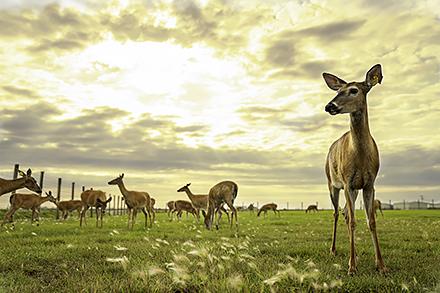Scientists Take Aim at Prion Disease

Healthy white-tailed deer at the National Centers for Animal Health in Ames, IA. (Photo by Hannah Hill)
Nearly $8 billion per year is, literally, wasting away and there is currently no way to stop it.
Chronic Wasting Disease (CWD) is an insidious, fatal illness that affects the brain, spinal cord, and many other tissues in deer, elk, and moose. The disease’s name comes from the most obvious symptom, dramatic weight loss.
CWD is one of a group of diseases called prion diseases or transmissible spongiform encephalopathies (TSEs). Other TSEs include scrapie, in sheep and goats, and bovine spongiform encephalopathy – mad cow disease – in cattle. Prions are proteins that exist throughout the body, but are most prevalent in the brain. Malformed prions lead to the disease.
Deer to human transmission of CWD is not known to occur under normal circumstances.
Scientists with the Agricultural Research Service (ARS) are on a mission to eradicate or control CWD in livestock, wildlife of economic importance, and potential wildlife reservoirs. While not normally considered an agricultural resource, the commercial deer breeding industry represents a $7.9 billion annual impact on the U.S. economy and supports more than 56,000 jobs.
“The National Animal Disease Center (NADC) [in Ames, IA] is uniquely poised to investigate CWD in the natural host [animal] in a controlled experimental setting,” said Eric Cassmann, veterinary medical officer at NADC. “The NADC has a decades-long history investigating the effects of interspecies transmission of animal prion diseases.”
One approach the researchers are taking is to develop new tests that can detect low levels of CWD in samples that are easily accessible like saliva, feces, and nasal swabs. They’re also investigating biomarkers that can detect target proteins at ultra-low levels in the blood through a technique called single molecule array.
“Our research is highly collaborative,” Cassmann said. “It’s critical to approach solving these complex issues from an interdisciplinary standpoint. That means working with engineers, bio-informaticists, and computer scientists to achieve practical and applied results that benefit producers.”
NADC researchers are investigating various rare prion protein genotypes in white-tailed deer. Data indicate that certain genotypes are frequently associated with CWD-positive cases and the scientists are looking for genetic answers.
“It’s unknown if this [connection] is due to there just being an overall low number of these genotypes around,” Cassman explained. “Through the natural host deer transmission studies at NADC, we hope to find a genotype that may be at least partially resistant to CWD. Even finding a genotype that [could] slow the onset of CWD to 5-7 years would give producers a tool for managing deer on their farms [by] cycling out breeding deer at a younger age before they could even develop disease.”
CWD research is taking place all over the world, Cassmann said, but it’s a difficult disease to work on, due in part to how long the disease takes to manifest in an infected animal. That being said, it looks like there are some prospects on the horizon.
“Studies in the natural host can take 2-7 years and the disease agent has the same [genetic] sequence as a naturally occurring protein in the host’s body,” Cassmann said. “The only difference is the shape of the protein – that is, how it is folded. That makes many of the assays we use unique to prion disease research. Collaborating with non-prion scientists takes an extra level of coordination due to the agent’s uniqueness."
Research on CWD aims to develop new tests that detect CWD earlier in the disease course, breeding deer for resistance to CWD, and studying the potential for CWD to cross into other animal species. – by Scott Elliott, ARS Office of Communications

